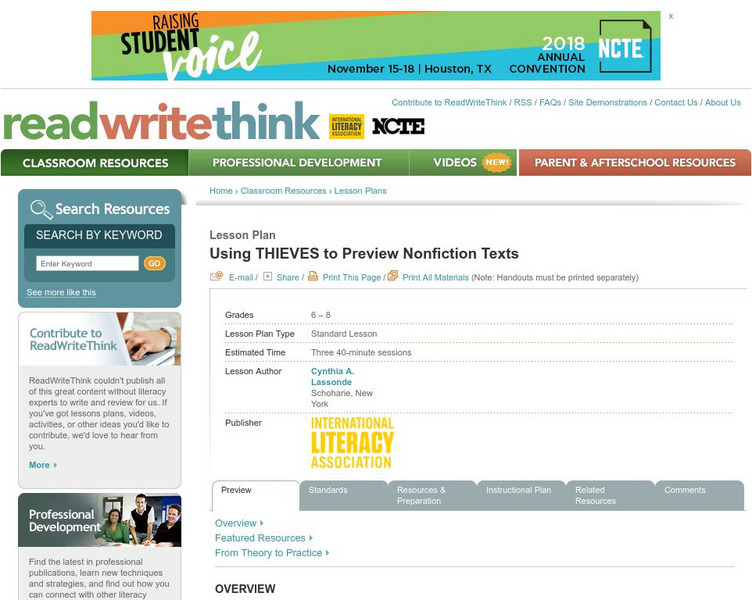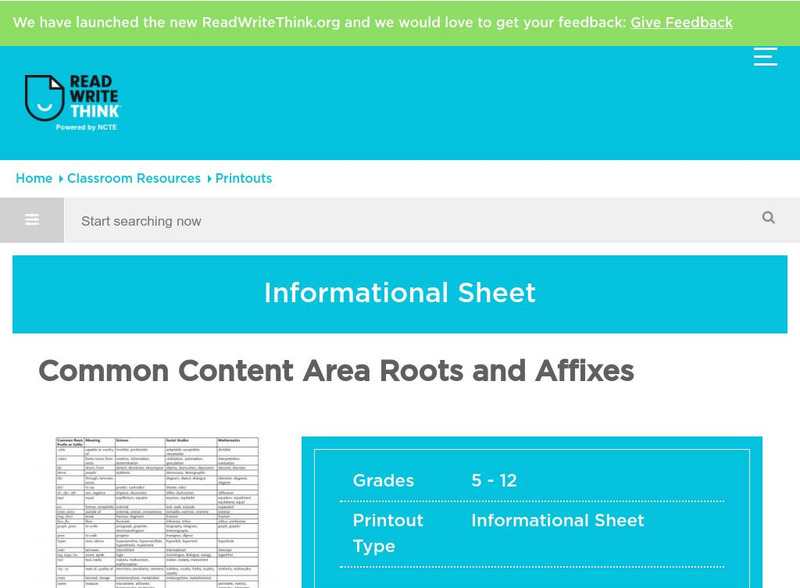Hi, what do you want to do?
Curated OER
True Crime
Students discuss reasons for the increase in violent crime across the country. They examine the factors to which increases in violent crime can be attributed. Students brainstorm consequences of the forces that have led to the decrease...
Curated OER
How Africans Became Slaves for the Colonists
Students complete a t-chart identifying the advantages and disadvantages of having indentured servants. In groups, they research the use of serfs and slaves in various cultures and share their responses. To end the instructional...
Curated OER
Sharks
Students delve into a study of sharks. For this biology lesson plan, students explore how sharks use their senses to detect prey and understand that the sharks body parts help it float and make it more buoyant.
Curated OER
Nutrients
Fourth graders understand the important nutrients in food and the value of each. In this nutrients instructional activity, 4th graders complete a chart giving examples of foods that contain that nutrient and a definition of the nutrient....
Curated OER
Underground Railroad
Students explore the Underground Railroad. In this U.S. history and technology lesson, students research an assigned topic related to the Underground Railroad, such as "abolitionist," "conductor," or "station houses." ...
Curated OER
Mining an Ore
Learners investigate how to determine the percent composition of a mineral in an ore. For this mining an ore lesson plan, students use chocolate chips cookies to represent an ore and they remove precious minerals (the chocolate chips)...
Curated OER
Rainforest Relationships
Students provided with opportunities to explore the animals and plant life that coexist in the various layers of the tropical rainforest. They appreciate the diversity of life in each layer. Students write a report on a particular plant,...
Curated OER
Hello My Name is . . . Helvetica
Students play various games to help create a classroom community. In this name recognition lesson, students combine their name recognition skills with newly learned art and geometric vocabulary. First students discover vocabulary that...
Curated OER
Can You Hear a Story?
Students listen to, analyze, and describe music. They explain relationships between music, the other arts, and disciplines outside the arts.
Curated OER
Hunger at Home
Students discuss the plight of the homeless in the U.S. and in their own community. They participate in a food drive for a local shelter. They role play being homeless and discover what it would be like to not have food or shelter.
Curated OER
Genetic Research: Decisions to be Made
Students examine the genetics involved in the human genome. They brainstorm the advantages and disadvantages to this discovery. They research different experts opinion and write a case study which addresses an ethical dilemma.
Curated OER
Silent Symbols Speak Loudly: Icons, Brands & You
Students view and discuss visual symbols around them every day, analyze symbols on United States one dollar bill, explore variety of meanings of same symbols depending on context and culture, and create their own money with symbols that...
Curated OER
Color Wheel Project
Students identify and describe the primary, secondary and tertiary colors.
They also identify the order in which these three categories of colors fit on the color wheel. Students then create a color wheel using any medium available...
Curated OER
Densities
Students explore the concept of density. In this density lesson plan, students determine the density of a crown and a sample of clay. They hypothesize about the densities of 4 liquids they are given including molasses, cooking oil, a red...
Curated OER
Evaporation and Temperature Change
Students investigate the relationship between evaporation and temperature changes. In this evaporation and changes in temperature lesson, students measure the changes in temperature of different solutions on a cotton ball.
Other
Ncrel: Reading Strategies: Before, During, and After [Pdf]
This page provides a detailed chart to aid students' understanding of texts. It goes through the steps of pre-reading, during reading, and after reading, outlining what students should be thinking about as they interact with a text. This...
Sophia Learning
Sophia: Reading Comprehension and Classroom Discussions
This tutorial focuses on active reading comprehension strategies including reading aloud, taking notes, summarizing, and writing in the margins of books to improve retention and class discussion. It includes two Flickr videos on active...
ReadWriteThink
Read Write Think: Using Thieves to Preview Nonfiction Texts
Contains plans for three lessons that introduce a nonfiction prereading strategy with the acronym THIEVES, which stands for Title, Headings, Introduction, Every first sentence, Visuals and vocabulary, End Questions, and Summary. In...
ReadWriteThink
Read Write Think: Anticipation Guide
Anticipating is an effective reading strategy for readers of all ages. Utilize this template and graphic organizer to help your students become better readers.
AdLit
Ad lit.org: Seven Strategies to Teach Students Text Comprehension
Comprehension strategies are conscious plans - sets of steps that good readers use to make sense of text. Comprehension strategy instruction helps students become purposeful, active readers who are in control of their own reading...
AdLit
Ad lit.org: Classroom Strategies: Monitoring/clarifying
The Monitoring/Clarifying strategy teaches students to recognize when they don't understand parts of a text and to take necessary steps to restore meaning. This technique is a component of the Reciprocal Teaching model in which teachers...
Free Reading
Free Reading: Guess What I'm Thinking?: Initial Sound Accuracy
A version of the "20 Questions" game. The instructor tells the class he is thinking of something that starts with, for example, /b/. The students have to come up with what the teacher is thinking of.
ReadWriteThink
Read Write Think: Using Word Storms to Explore Vocabulary and Encourage Thinking
Contains plans for seven lessons about working dogs that teach critical thinking skills and a vocabulary strategy called Word Storms. In addition to objectives and standards, this instructional plan contains links to sites used in the...
ReadWriteThink
Read Write Think: Common Content Area Roots and Affixes
This table offers 50 or so common roots, prefixes, and suffixes, their definitions, and sample words in the content areas. L.9-10.4b Patterns/word changes




















![Ncrel: Reading Strategies: Before, During, and After [Pdf] Graphic Ncrel: Reading Strategies: Before, During, and After [Pdf] Graphic](https://static.lp.lexp.cloud/images/attachment_defaults/resource/large/FPO-knovation.png)







